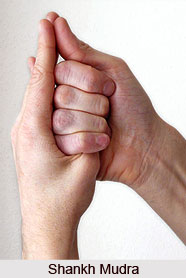 Shankh Mudra is a common Mudra practiced in temples. Shell Mudra is good for solving problems and ailments related to Vishuddhi Chakra, that is the energy centre in the throat area. The Mudra has been incorporated in various schools for self-development and growth. Shankh or Conch shell is regarded pious by Hindus as it is believed to invoke positive energy. Typically, Conch shell is blown during all Hindu rituals. Shankh Mudra is practiced by positioning and clasping of the fingers simulating a conch shell. Whilst practicing Shankh Mudra, the person is suggested to chant "Om" several times and then focus and listen to the silence within oneself for few minutes, afterwards. This should be practiced with closed eyes and controlled breathing in a relaxed way. Shankh or Shell Mudra has a very soothing and relaxing effect. The Shankh Mudra drives away every kind of problem in the throat. It also has a very calming effect and leads to collection in silence.
Shankh Mudra is a common Mudra practiced in temples. Shell Mudra is good for solving problems and ailments related to Vishuddhi Chakra, that is the energy centre in the throat area. The Mudra has been incorporated in various schools for self-development and growth. Shankh or Conch shell is regarded pious by Hindus as it is believed to invoke positive energy. Typically, Conch shell is blown during all Hindu rituals. Shankh Mudra is practiced by positioning and clasping of the fingers simulating a conch shell. Whilst practicing Shankh Mudra, the person is suggested to chant "Om" several times and then focus and listen to the silence within oneself for few minutes, afterwards. This should be practiced with closed eyes and controlled breathing in a relaxed way. Shankh or Shell Mudra has a very soothing and relaxing effect. The Shankh Mudra drives away every kind of problem in the throat. It also has a very calming effect and leads to collection in silence.
Shankh Mudra can be performed by encircling the thumb with the four fingers of the right hand. The next step is to touch the right thumb to the extended middle finger of the left hand. Together, the two hands resemble the shape of a conch shell. The practitioner is advised to hold the hands in front of his/her sternum and recites the scared Hindu mantra, Om, with it. This can be done three times every day for fifteen minutes. This Mudra can be practiced as often and as long as the practitioner wants, until his desired outcome is achieved. Alternatively, Shankh Mudra can also be exercised three times daily for 15 minutes, as a course of treatment.
Benefits of Shankh Mudra
* They are used effectively as tools or aids for calming and controlling the mind to facilitate and promote the process of Meditation.
* Shankh Mudra possesses curative as well as therapeutic value.
* When properly practiced, Shankh Mudra promotes and leads to an enhancement of ones mental state of serenity, calm and harmony.
* Shankh Mudra or Conch Shell Mudra also cures various types of ailments in the Vishuddhi Chakra or throat region.




















